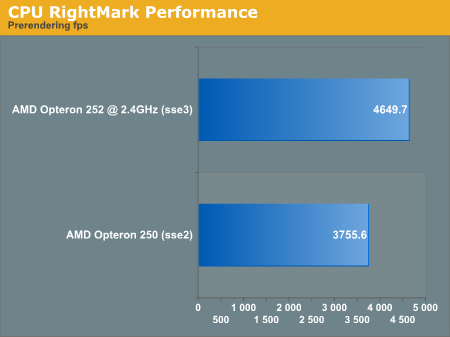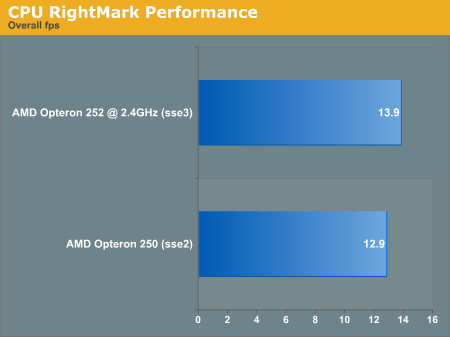AMD K8 E4 Stepping: SSE3 Performance
by Derek Wilson on February 17, 2005 12:05 AM EST- Posted in
- CPUs
SSE3 Performance Analysis
Before running these tests, we confirmed that SSE3 was enabled with the Opteron 252 through CPU-Z.The first test that we will look at is DivX encoding. We used DivX 5.2.1 with AutoGK 1.91 as a front end. Chapters 19, 20 and 21 of The Chronicles of Riddick were used as the test material for this analysis. We turned off audio and used the 75% quality setting.

The second test that we looked at was purely synthetic. CPU RightMark uses the processor to manage the physics and rendering of a 3D scene. There are lots of configuration options, but we went with the default for each CPU that we tested (just start up the program and hit run). The highest level of floating point support is chosen automatically in each case (SSE2 for Opteron 250, and SSE3 for Opteron 252 @ 2.4GHz).













48 Comments
View All Comments
DerekWilson - Monday, February 21, 2005 - link
#46 and #47arent monitor and mwait like hardware semaphores/mutexes?
PrinceGaz - Saturday, February 19, 2005 - link
#46- MONITOR tells the processor to detect changes in memory locations (typically in cache), and MWAIT puts a thread into low-power "sleep" until those memory changes are detected.MONITOR and MWAIT are meaningless to processors that are only running a single thread, therefore the AMD SSE3 capable processors will just treat them as no operation (it has to be aware of there existence so it can skip past them correctly, and not potentially crash like #44 asked).
Instructions designed to put one thread to sleep so that the processor can use its full resources on the other thread are only relevant when a single processor is running two or more threads simultaneously. Single-threaded processors will always dedicate full resources to the thread they are running and not put them to sleep as that would be pointless. The O/S still handles thread-switching normally, regardless of how many threads the processor is running.
pxc - Friday, February 18, 2005 - link
#45, that would be disasterous (NOP for a wait condition would mean a thread wouldn't wake up). :P MONITOR and MWAIT are useful for HyperThreading, but not exclusive to HT. Any application with multiple threads can benefit from its use. AMD's internal implementations will of course be different, but the instructions will behave the same way.PrinceGaz - Friday, February 18, 2005 - link
#44- they'll almost certainly just treat monitor and mwait as a NOP (no operation instruction)quanta - Friday, February 18, 2005 - link
Since SSE3-based AMD64 CPUs don't have hyperthreading, will application using monitor and mwait crashes the Opterons?Viditor - Friday, February 18, 2005 - link
Derek - By running at 75% quality, aren't you minimizing the effects of lddqu, as this is mainly of use for motion estimation (which is greatly reduced at lower quality settings...)?(Thanks to Mike S for pointing this out to me...)
Viditor - Friday, February 18, 2005 - link
PrinceGaz - "It definitely looks like these new E stepping chips run hotter"Unfortunately, you can't really tell with AMD chips...
All we really know is that under absolutely NO circumstances will it run higher than 92.6w...
I do wish TDP was a standard across all companies, but I guess that would be impractical.
Sadly, this is a measurement that none of the review sites ever make...
Viditor - Friday, February 18, 2005 - link
Icehawk - "I've worked for several large corporations (Fortune 500) and none of them have AMD servers anywhere..."40% of the Fortune 500 companies are now using Opteron servers. A large percentage of the most powerful new supercomputers are Opterons.
I am sure that while you worked for those companies the did not have Opterons, as this is only a recent development (over the last year).
"most vendors only offer Intel boxes"
This too has changed over the last year. As of now, the only major vendor to be Intel only is Dell. In fact, Sun has cancelled their Xeon line in favour of Opterons...
http://www.theregister.co.uk/2005/02/10/sun_kills_...
PrinceGaz - Friday, February 18, 2005 - link
#39- although the 2.4GHz x50 D4 Opteron also has the same 85.3W TDP as the 2.2GHz part, the 2.6GHz x52 has a TDP of 92.6W which is higher than any other Opteron including the 130nm parts.It definitely looks like these new E stepping chips run hotter, but we need power consumption and temperature tests to say for sure.
Brunnis - Friday, February 18, 2005 - link
#38Well, AMD said that power requirements would drop for chips at the same frequency, if I remember correctly. The TDP doesn't say anything about processors currently available. For all we know the 85W figure could be for a future 4GHz Opteron. I'm exaggerating, but you get my point. :)